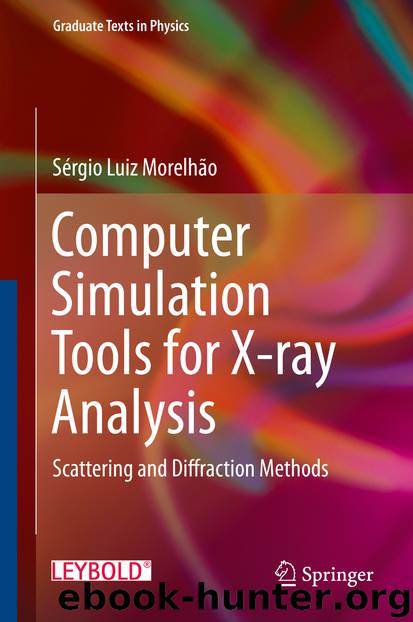Computer Simulation Tools for X-ray Analysis by Sérgio Luiz Morelhão

Author:Sérgio Luiz Morelhão
Language: eng
Format: epub
Publisher: Springer International Publishing, Cham
Note 5.3: Integrated Intensity, Rotating Crystal Method (Zachariasen 1945).
Given
as the incident and diffracted wavevectors, respectively, described in spherical coordinates in relation to the rotation axis ϕ, Fig. 5.9. Following a procedure that is similar to that used in Exercise 5.2(b), the area under the intensity curve as a function of the rotation angle is
whose volume element is calculated by the Jacobian of the transformation: and
that is, , resulting in
Exercise 5.5.
Single crystal goniometers spatially orient the sample’s diffraction vectors starting from the orientation matrix. (a) With two crystallographic directions identified beforehand A = [A 1 A 2 A 3] and B = [B 1 B 2 B 3],9 find the orientation matrix and the crystalline lattice base vectors, i.e. edge vectors , , and , in an x y z coordinate system where the direction A coincides with the z-axis and direction B is within the x z-plane. (b) In a monoclinic lattice, and β ≠ 90∘, what is the orientation matrix for directions A = [100] and B = [010]? (c) With being the incident wavevector, which are the rotations necessary for reflection 002 to diffract on the x z incidence plane?
Answer (a): Directions A and B correspond to vectors and . Edge vectors, in matrix notation , , and , are defined arbitrarily since the unit cell geometry is maintained (see Exercise 4.2). From the directions A and B, an orthonormal basis is created
Download
This site does not store any files on its server. We only index and link to content provided by other sites. Please contact the content providers to delete copyright contents if any and email us, we'll remove relevant links or contents immediately.
Alchemy and Alchemists by C. J. S. Thompson(3416)
The Elements by Theodore Gray(2947)
The Club by A.L. Brooks(2805)
How to Make Your Own Soap by Sally Hornsey(2786)
Drugs Unlimited by Mike Power(2508)
Wheels of Life by Anodea Judith(1946)
Cracking the Sat French Subject Test, 2013-2014 Edition by The Princeton Review(1797)
Perfume by Jean-Claude Ellena(1758)
Cracking the LSAT, 2012 Edition by Princeton Review(1755)
The Flavor Matrix by James Briscione(1735)
The Cosmic Machine: The Science That Runs Our Universe and the Story Behind It by Scott Bembenek(1707)
MCAT Physics and Math Review by Princeton Review(1603)
1000 Multiple-Choice Questions in Organic Chemistry by Organic Chemistry Academy(1584)
The Thing Around Your Neck by Chimamanda Ngozi Adichie(1539)
Handbook of Modern Sensors by Jacob Fraden(1517)
Cracking the SAT Premium Edition with 6 Practice Tests, 2017 by Princeton Review(1498)
Synchrotron Light Sources and Free-Electron Lasers by Eberhard J. Jaeschke Shaukat Khan Jochen R. Schneider & Jerome B. Hastings(1497)
A is for Arsenic: The Poisons of Agatha Christie (Bloomsbury Sigma) by Kathryn Harkup(1474)
Harry Potter All Books: 8 Books by J.k.rowling(1454)
